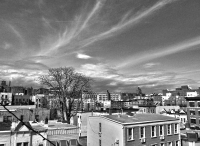
The Northwest Bronx Community and Clergy Coalition organized an event about the gentrification of the Bronx last Wednesday. Flickr
By Kenneth Iselhart
Room 305 of Dealy Hall was teeming with students last Wednesday for a discussion titled, “Is the Bronx the New Brooklyn?” Led by student community organizers working with the Northwest Bronx Community and Clergy Coalition (NWBCCC), the meeting fostered conversation about gentrification and displacement in the Bronx.
Standing in front of a Powerpoint displaying images of signs saying “Gentrification is the new colonialism” and “Gentrification displaces low-income residents,” the student community organizers gave an overview of gentrification as a basis for the conversation. They defined it as “the process of renewal and rebuilding accompanying the influx of middle-class or affluent people into deteriorating areas that often displaces poorer residents.” This was juxtaposed to their definition of revitalization, which differs in that a community remains affordable for low income residents in the latter.
The highlight of the evening, however, was when Eva Diaz, co-owner of a restaurant in the Bronx called Calientito, shared her story. After immigrating from Puerto Rico 11 years ago, Diaz noticed a lack of Puerto Rican cultural awareness. “I really noticed the impact of not having a voice,” she said. Diaz and her husband decided to open Calientito as a restaurant that would celebrate their heritage. “Calientito,” she told students, “for my family represented… bringing to the South Bronx back the Puerto Rican and the Caribbean culture.”
The South Bronx area around Calientito was once, as Diaz noted, “grey and silent.” Now, it has become a hub for development and gentrification. At first, said Diaz, “Our landlord was definitely opposed to the new community that was coming in,” but she mentioned that before long, “he saw the dollar sign,” and began leasing property to outside developers for high prices. Because Calientito’s lease was signed before gentrification in the area began, Calientito’s rent was much lower than those of other businesses on the block, which Diaz claimed did not please the landlord. So instead of waiting out the lease, she said “he’s created ways to push us out and break our spirit.” Diaz accused the landlord of refusing to fix damages such as a major leak in the dining room, not providing air conditioning and heat and making it difficult for the restaurant to obtain a beer and wine license. She calculates that these obstacles cost the business around $40,000 in the summer, a time that is crucial for many restaurants. Since Frank Torres is the landlord of Diaz’s home as well as her restaurant, this strained relationship has led to the displacement of Diaz’s family from its home of 11 years.
Diaz and her husband have been to multiple lawyers and courts to try to solve these issues. She mentioned that Welcome2theBonx, an online newspaper, and SoBro, a non-profit organization in the South Bronx offers entrepreneurial development and business assistance. These resources have helped her business to overcome some of these obstacles. However, these efforts were not enough and on Friday, Calientito was evicted. An article in DNAinfo noted how some local residents are calling Calientito the first victim of gentrification in Port Morris.
Students leading the discussion highlighted both the positive and negative aspects of gentrification. Often times, gentrification leads to a reduction in crime, increased property values, reduced vacancy rates and increased local fiscal revenues. They argued, however, that human dignity and culture are too important to lose sight of in the development process.
Diaz emphasized that since the community cannot stop gentrification from happening, the community should focus on how it will become gentrified. “My pocket is very thin, so I’m not going to prevent them from coming in, I just want to make sure that… Calientito and the other things that make the Mott Haven area what it is, stay that way.”
Student organizers gave an example of purposeful, community led gentrification with the case of the Kingsbridge Armory. The NWBCCC and members of the community had fought for 17 years to ensure that the developers revitalized the property with the interest of the neighborhood in mind. The Kingsbridge Armory will be developed into the world’s largest ice arena, creating construction jobs for many Bronx residents. The Kingsbridge Armory will also be developed using goods and services from local Bronx businesses.
Another point of discussion was the recent “Bronx is Burning” rave that has come under fire for being insensitive to the community. The name is a reference to the 1970s, when entire neighborhoods were abandoned in the Bronx and landlords set their own buildings on fire to collect insurance payouts. Local residents were indignant over the decorations of the party metal trashcan bonfires and bullet-studded cars- because they seemed to make a mocking caricature of the borough and its history. Attended by A-list celebrities such as Adrian Brody and Kendall Jenner, as well as Bronx Borough President Ruben Diaz Jr., the event was held by real estate developers and was meant to be an opportunity for networking. Ava Diaz of Calientito added that the event was too dark and alcohol-fueled to do any real networking.
Students came out to the event for many different reasons. Some were Bronx residents concerned about the changes they were seeing in their neighborhoods, and some came because they felt a connection to the community in which they go to school. Others felt gentrification was an issue that they did not fully understood and wanted to learn more.
The student organizers plan on holding more discussions at Fordham and will invite students to future meetings with the NWBCCC. One of the organizers, Brian Collins, FCRH ’18, said, “The Fordham community itself has a lot of potential to enact change.” He hoped that students who attended the discussion would share with other students what they had learned.
